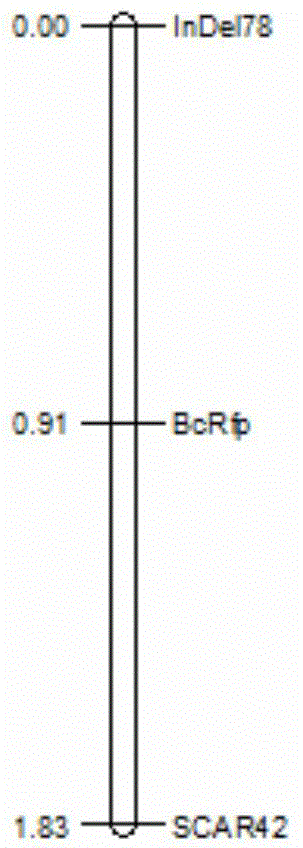Molecular marker for cabbage cytoplasm male sterile line restore gene and application thereof
A fertility restoration gene and male sterility technology, which is applied in the determination/inspection of microorganisms, DNA/RNA fragments, recombinant DNA technology, etc., can solve the problems of slow breeding process, time-consuming and laborious, long cycle, etc., to speed up the breeding process , the effect of improving the selection efficiency
- Summary
- Abstract
- Description
- Claims
- Application Information
AI Technical Summary
Problems solved by technology
Method used
Image
Examples
Embodiment 1
[0036] Example 1: Discovery of InDels markers linked to Chinese cabbage CMS7311 fertility restorer gene BcRfp
[0037] (1) Construction of isolated groups
[0038] The Chinese cabbage male sterile restorer line 01S325 bred from 5 generations of self-crossing of 83-2 Chinese cabbage (see Xiangping, 1996, "Paddy Field Autumn Vegetable Combination Model", Vegetables, 01: 28) was used as the male parent to give male sterile The breeding line CMS7311 was pollinated, and all the obtained F1 plants were fertile. F 2 Among the 258 sown individuals, the field fertility survey showed that 186 were male fertile and 72 were male sterile single plants. The x2 test showed that the fertility segregation ratio was 3:1 (x 0 2 = 1.013,x 0.05 , 1 2 =3.841), indicating that the fertility restoration of the male sterile line is a dominant gene controlled by a single gene.
[0039] (2) DNA extraction and marker screening
[0040] (1) Extract the genomic DNA of the material to be tested with...
Embodiment 2
[0046] Example 2: Transformation and identification of SCAR labeled InDel42
[0047] (1) Transformation of SCAR markers
[0048] Since the PCR product marked InDel42 in the sterile material lacks 12 bp compared with the fertile material, it is difficult to effectively separate the two by 0.8% agarose gel electrophoresis, and the marker can only be distinguished by converting the marker into a SCAR42 marker. The sequences in the fertile plants are as follows (the underlined part is the sequence missing from the sterile material):
[0049] ATGGAAGAAGCCCTAAGAAAGT TCAACGAATCTACCTACTCCTTCATACCCGGTTACGAACCCGACCCGATTCCTCTAACGAGAATCTTTGCCAATGATGCAAACTCCCCGCAGGTTAACAACACACCGTCTTCAAAGGAGGCAATAGTGACCATCACCGGATCTGGCAGGACAAGGTACCGTGGCGTTCGCCGAAGGCCGTGGGGACGTTACGCGGCGGAGATACGTGATCCCACGTCGAAGGAGAGACGTTGGCTCGGAACGTTCGATACGGCGGAGCAAGCCGCTTGTGCTTACGACTGTGCAGCTCGTGAGTTTCGTGGATCTAAGGCTCGGACCAACTATACTTATC CTGTTACTAATCCTGTT GCCGAGCCTAGATTCTCTTTCTCCTCAAAGAAATCTATGAAGGCCGTTCGTTCTCCTATACCGTCACCTCT...
Embodiment 3
[0054] Example 3: Application of two markers InDel78 and SCAR42 in the assisted selection of the Chinese cabbage CMS7311 fertility restorer gene
[0055] (1) Using the CTAB method to extract the genomic DNA of the material to be tested, the specific method is the same as before;
[0056] (2) PCR reaction
[0057] (1) PCR reaction system: 25ul system, the contents of each component are: 20ng template DNA; 2.5ul10×buffer; 1.8mM MgCl 2 ; 0.25mmol / L dNTP; 1pmol / L Primer: 1.5U Taq DNA polymerase; ddH 2 O make up to 25ul, mix well, and centrifuge;
[0058] (2) PCR amplification program: pre-denaturation at 94°C / 5min, then 94°C / 60s, 56°C / 45s, 72°C / 1min, after 35 cycles, extension at 72°C for 5min;
[0059] (3) Electrophoresis: Take 6ul of PCR amplification product and mix with 2ul of 6×loading buffer, put it into 0.8% agarose gel, electrophoresis at 150V for 25min, observe and take pictures in gel imager after EB staining ;
[0060] (4) Result analysis:
[0061] When the target...
PUM
 Login to View More
Login to View More Abstract
Description
Claims
Application Information
 Login to View More
Login to View More - Generate Ideas
- Intellectual Property
- Life Sciences
- Materials
- Tech Scout
- Unparalleled Data Quality
- Higher Quality Content
- 60% Fewer Hallucinations
Browse by: Latest US Patents, China's latest patents, Technical Efficacy Thesaurus, Application Domain, Technology Topic, Popular Technical Reports.
© 2025 PatSnap. All rights reserved.Legal|Privacy policy|Modern Slavery Act Transparency Statement|Sitemap|About US| Contact US: help@patsnap.com



